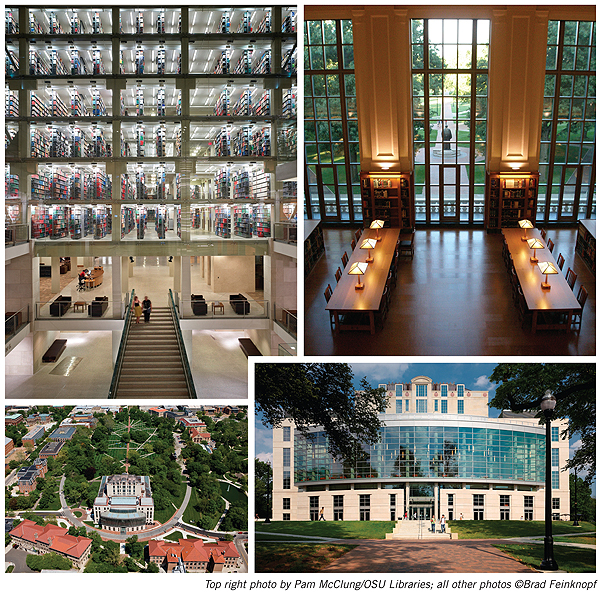New Landmark Libraries 2012 #3: William Oxley Thompson Memorial Library, Ohio State University
For the Buckeyes, Less Is More
William Oxley Thompson Memorial Library | Ohio State University | Columbus Architect: Acock Associates ArchitectsVitals
OPENED 2009 Renovation and new construction Main library SIZE 306,000 square feet COST $78.7 million LEED-NC No Student Pop 56,000
Ohio State’s decision not to increase the size of it’s 306,000 square foot library, originally built in 1913 and expanded in the 1950s and 1970s, might seem counterintuitive for this behemoth campus. But planners and stakeholders agreed that the best way to be student centered was aggressively to improve and refocus their library’s space.
That strategy, coupled with restoring a historic east-west connection through the building to reignite the library’s central position in the campus’s historic “oval,” resulted in a library with more usable space, tripling use to 12,000 daily visitors and rekindling a love of the library by faculty, students, and administrators that had long faded.
The exhaustive planning, careful consideration of library as a symbolic and transformative place, and attention to every detail that could make or break a great student experience resulted in a watershed project for this campus. Not only is the result a new landmark for the profession, the process is ripe for gleaning and redeploying by other institutions. Gund Partnership was the associate architect.
Involving stakeholders
A highly structured input process, involving layers of stakeholders, zeroed in on what parts of the existing library meant the most, what didn’t work, and what would be meaningful. From there, a series of painstaking decisions of what to keep, restore, change, and remove took place. Five years of planning included a web-based suggestion box, systematic electronic surveys, and many meetings with alumni groups, staff, librarians, and faculty.
One of those difficult decisions involved the closed stacks developed in the 1950s. The stacks themselves were negatively perceived, but the tower in which they were housed was much loved. Retaining the campus landmark won out after considerable debate, but below the roofline its skin was removed and replaced with glass, creating a glass stack tower of books. The tower’s top floor, once a mechanical room, became a reading and event space with stunning views of the campus and the community beyond.
Externally, the change was equally dramatic. Green space and a pedestrian connection to a lake replaced a parking lot. Pathways with reused flagstones, the preservation of trees, and the addition of 106 bike racks improved pedestrian access. An east-west thoroughfare through the building reintroduced a library-centric campus and eased pedestrian flow.
“It’s a spectacular makeover of a facility overdue for refurbishment, creating a legible plan with open flexible space while celebrating the legacy stack tower and its collections as a central core element,” a judge commented.

From dark to light
From claustrophobic and dark, the library took on a light and airy presence. Historic and almost forgotten spaces that had been chopped and covered up were restored, including a 30'-tall ceiling in the 1913 “grand reference hall” that became symbolic of the entire effort. The demolition of the 1950 and 1977 additions and construction of a new west façade better balanced the scale of the original Beaux Arts building, delighting both students and visitors.
While the library wasn’t a study hot spot before renovation, it certainly became one after. Even with reader seats increased by more than 100 percent, the 1800 new seats are often not enough to satisfy demand at peak hours.
The space for increased seating wasn’t free. It was captured from other functions. Forty percent of the collection is now housed off-site, with 1.25 million volumes remaining, largely in the tower. This includes 250,000 special collections volumes readily accessible via a central service point on the first floor. Additionally, some library operations were relocated to other facilities.
Strategic partnerships with dedicated space abound. Campus IT leadership and its laptop support service are located in the library. Dining services provides the café, and the Columbus Metropolitan Library System operates a leisure reading collection available to students.
Designed prior to Ohio State’s Leadership in Energy & Environmental Design (LEED) certification requirement, the project, nevertheless, has a strong grounding in sustainability principles and energy-efficiency strategies. Decisions not to increase space but reuse the original and 1951 buildings, add green space, recycle existing furnishings, source locally, and deploy high-performance building systems, materials, and finishes confirm that this project demonstrates an ecoethic.
How did a project of this size get funded? The Athletics Department rose to the problematic challenge with a $9 million kickoff gift. With that and a truckload of credibility stemming from extensive stakeholder input that led to a compelling vision of a library for the future, another $30 million was raised privately. The state and the university provided the remaining funding.
From a large but dark and claustrophobic facility, the planning leadership unearthed the essence of the building’s 1913 roots and, with a well-orchestrated set of moves like celebrating the legacy stack tower, planted a thoroughly modern and spectacular library for the future.
RELATED
ALREADY A SUBSCRIBER? LOG IN
We are currently offering this content for free. Sign up now to activate your personal profile, where you can save articles for future viewing










Add Comment :-
Comment Policy:
Comment should not be empty !!!
Kevin Henegan
Thanks, Pam--the credit has been corrected and updated. Thanks for the clarification.Posted : Jul 09, 2012 06:31
Pam McClung
You should be aware that the top right photo should be credited ©University Libraries, Pam McClung photographer (you say that they are all from Brad Feinknopf but that one was not taken by him.Posted : Jul 07, 2012 03:13
Keenan
I used to love the "claustrophobic and dark" because there were plenty of spaces to catch a quick nap between classes.Posted : Jun 30, 2012 07:00
jonesy
What?! A successful athletics program made a contribution to academics?! That's just outlandish.Posted : Jun 29, 2012 06:30
teetop
What about Deck 8?Posted : Jun 29, 2012 05:25